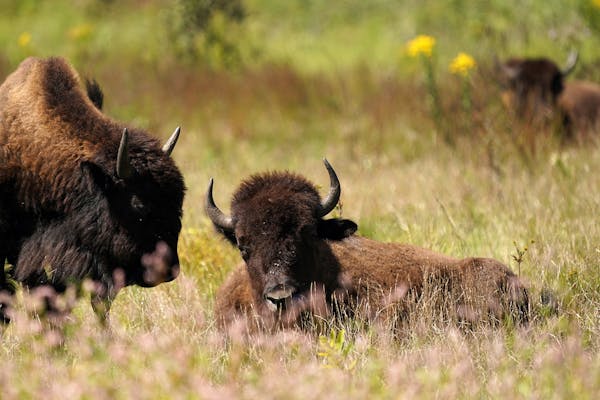A bull housed at Olmsted County's small Zollman Zoo will help Minnesota's effort to bring back a genetically pure herd of American plains bison.
The county worked with the Minnesota Department of Natural Resources (DNR) this fall to do a genetic test on the bull and found that not only is it pure bison, but its lineage is different from the other buffalo kept in the state. That means its offspring will be key to providing the genetic diversity needed to build a healthy herd.
The DNR sent Zollman Zoo, just west of Rochester, three female bison from Minneopa State Park to live and mingle with the bull. The four bison will be kept at the zoo, and with any luck their offspring will be spread out among two state parks and the Minnesota Zoo to keep growing the herd, said Ed Quinn, natural resource program supervisor for the DNR.
"Genetically, this gives us a really good slice of the pie that we didn't have much of," Quinn said. "With Olmsted in the partnership, now we'll have another place where bison are produced and where folks can come see them."
The last wild bison disappeared from Minnesota nearly 150 years ago, when the animals were hunted to the brink of extinction. While numbers have rebounded to an estimated 500,000 nationally, the vast majority of those — more than 90% — have been bred with cattle. Genetically pure bison are hard to find, and almost all come from one of just a handful of national parks.
Small herds have been kept in Minnesota since at least the 1960s. The DNR and the Minnesota Zoo in Apple Valley were delighted to discover that almost all of the bison kept on public land in the state were genetically pure.
They started the conservation herd partnership in 2011 as a way to keep growing the number of pure bison kept in the state and weed out those that had been bred with cattle.
The state now has about 150 of the animals spread out over four locations: Blue Mounds State Park in Luverne, Minneopa State Park in Mankato and at the Minnesota Zoo and Zollman Zoo.
It takes about 500 bison to create a self-sustaining population with enough genetic diversity to avoid inbreeding, Quinn said.
But Minnesota now has a fraction of the prairie landscape it once did; there are few grasslands big enough to hold significant numbers of the animals that once covered much of the state.
The DNR plans to reach 500 bison slowly by building up a network of parks where a few hundred, a few dozen or even just a few can be kept. They will then be shifted around the participating sites based on their lineage to stay genetically diverse.
Dakota County is also interested in joining the partnership. The county has asked lawmakers for up to $560,000 to introduce about 15 bison into the county's Spring Lake Park Reserve near Hastings.
If lawmakers approve the funding this spring, the bison won't just be an attraction for parkgoers, but will play a key role in restoring the reserve's prairie lands, parks officials said.
Greg Stanley • 612-673-4882

Souhan: This is KAT's chance to prove Flip Saunders was right

The story of Hercules the cat: Rescued in 2022, Target model in 2024

Minnesota State Patrol celebrates diverse new class of troopers

